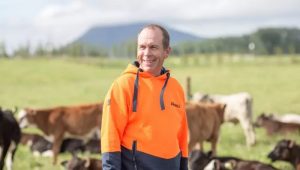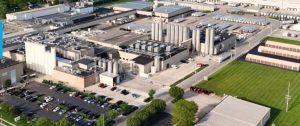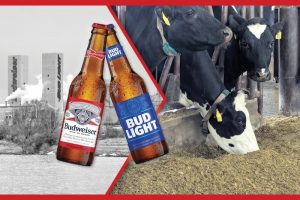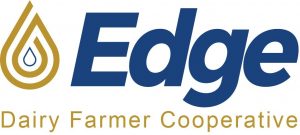
Robotic milking may be the future of dairy farming but it won’t make dairy farming easy.
“We’ve been through some really tough times,” said Chad Schumacher, operator of Schumacher Dairy Farm in Plainview, which milks around 150 cows using two Lely robots that were installed in 2014.
The farm in Wabasha County was purchased by his late father, Gary Schumacher, in 1973, when he bought it from his mother.
“They milked in an old tie-stall barn for a long time, up until eight years ago,” said Schumacher, who also farms about 1,000 acres of corn and soybeans.
Two years after the robots were installed, Gary Schumacher learned that he had a brain tumor. He made it another year a half before he passed away.
“This was really plopped upon me to kind of continue all this, and I’m working with my kids and my nephew, and my mom, even though she’s got a full-time job,” Schumacher said.
‘Tremendous consolidation’
Marin Bozic is a dairy economist and assistant professor in dairy foods marketing economics in the Department of Applied Economics at the University of Minnesota. He said when he started his work in U.S. dairy markets 15 years ago as a graduate student at the University of Wisconsin-Madison, there were 60,000 licensed dairy farms in the country.
“We are about 30,000 now in the U.S.,” said Bozic. “So tremendous consolidation has taken place over the last 15 years.”
Dairies are feeling forced to get bigger to be profitable, said Bozic, along with more streamlining and robotic systems. He said that farmers who weren’t early adopters of robotic milking systems — like the Schumacher family was — are now coming around to install them.
“We’ve seen more of that on larger dairies that would typically not use robots, but would rely on rotary parlors and cheap labor,” said Bozic. “I think that robotics will be increasingly important going forward, as the labor market tightens.”
Schumacher believes in sharing the good and the bad after installing robots on their farm. Right now, things are good in the industry for them, he said, and their milk is being sold at local Kwik Trips and at other stores in southeast Minnesota. But the robots have not solved their problems, and instead have created some new ones.
Milk prices down, input costs up
In 2014 – when milk prices were high – Gary Schumacher felt his body starting to give out, and decided with his son to invest in a robotic dairy barn. They knew before the robots were installed that it would take around eight years to see profits from it.
“What we really didn’t take into account was for the milk prices to go down and all the inputs to go up,” said Schumacher. “Right after we started putting (the robots) in, the dairy market really fell. That’s something we didn’t have control over.”
The prices remained low for several years after construction of the robot barn, he said, up until about the last year-and-a-half, when markets have rebounded.
“But so have all our input costs,” said Schumacher. “Our fertilizer inputs are just about double as they were last year and the previous year.”
Bozic said many U.S. dairy farmers are choosing to expand production to make up for the rising input prices.
“Typically, you’ll counter that by spreading those costs over more cows,” Bozic said.
Schumacher said that starting with his father, their dairy takes a lot of pride in its small, quality herd which they’ve been A.I. breeding for over 35 years.
“We’re still just a small dairy, but with two robots,” said Schumacher.
When they transitioned to the robot barn, they only added 75 cows, which was enough to fill the robots.
“You want to get the thing paid for right away, and get ahead of the curve,” he said. “So you want to get the maximum production you can out of your robots.
Weathering the unstable industry would’ve been easier if they expanded their herd to be much larger, he said, but he’s unsure if that’s sustainable or good for overall health of the herd.
“If you have more cows, you have more room for error, because you got some more income coming in,” he said. “But if you’re going to put in a big system and a big robotic herd, I don’t think your problems are going to go away and that you’re going to be rolling in the money.”
Hidden maintenance
Schumacher said at first with the robots, everything went well and the new equipment brought fresh life to the operation, and they were pleased with the “state-of-the-art” tunnel vent barn. But once the warranty ran out after a couple of years, he said their struggles with the robot barn began to get more serious.
He said “hidden maintenance” fees to fix the robots have taken a lot of money out of the operation, and estimated they’ve spent $5,000 a month on the robots in the last couple of years.
“With the margin of error being as tight as they are right now, that is really tough to cash flow, you know, and we’re at the mercy of the creameries on what they give us for our price for milk,” Schumacher said. “A farmer, we’re kind of stuck, and we sell whatever we can – we pay retail and then we sell for wholesale, it’s a tough racket.”
The robots milk 24 hours a day and clean for 20 minutes at night and in the morning. Schumacher said it’s given him more free time to do other things on the farm and attend his kids’ high school sporting events, but problems can arise with the robots at any time. He’s alerted on his phone when breakdowns happen.
“Everybody thinks that if you put a robot in, you can just walk away,” he said. “It’s a far thing from that.”
In-person service is required on the robots if Schumacher can’t figure out an issue, or it can’t be explained over the phone.
They bought the robots from a “small mom-and-pop shop” in town, and over a year ago that business was bought out by a bigger one, which Schumacher said now oversees clients in his area along with areas for three other dealerships.
Since under the new ownership, Schumacher said getting help to the farm is more difficult because the service is no longer local. Sometimes when he calls, the service worker is at another farm fixing an issue.
“There’s been times I’ve waited up to five and six hours to have somebody come and get me going, and for a dairy farm, that’s a big deal,” he said. “If they’re not getting milked like they’re supposed to be, cows will end up getting sick.”
Growing up, Schumacher learned how to do his own maintenance. But even though he’s learned how to operate the robots, there’s some issues he’s not capable of fixing.
“And that’s kind of how I think they want this technology,” he said of the continued service. “They want to do it so they can work on it, and then really charge you – it’s a bad deal.”
Real life challenges
Schumacher and his wife, Amy, have three children – Ashlyn, Jace and Jordyn – who’ve all grown up on the farm.
In 2021, 19-year-old Jordyn – in her first year of college studying dairy science Northeast Iowa Community College – was diagnosed with Hodgkin lymphoma stage 4, a cancer that affects the body’s lymphatic system.
She remained a full-time student while she underwent chemotherapy treatment, made the dean’s list, and in the spring of last year was named Wabasha County’s dairy princess after serving on the court for four years.
“I have a daughter who is a dairy princess,” Schumacher said proudly.
Last month, a scan showed that she had no signs of cancer, but will continue to be tested for the next two years.
Schumacher said his daughter is very interested in dairy but she’s seen the struggles that go with it.
“She’s really passionate about the dairy industry and that’s just very rare and very hard to find,” he said. “But I told her, ‘the farm should be the last thing you should have to worry about.'”

























